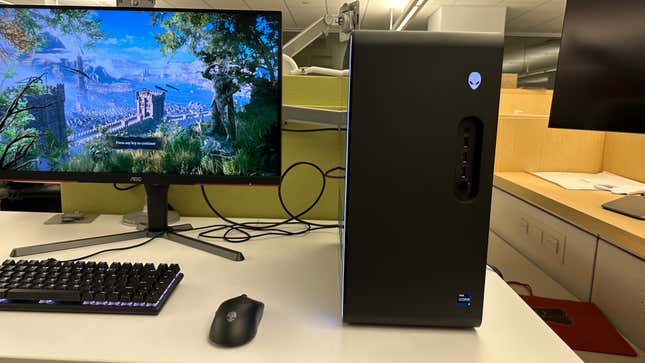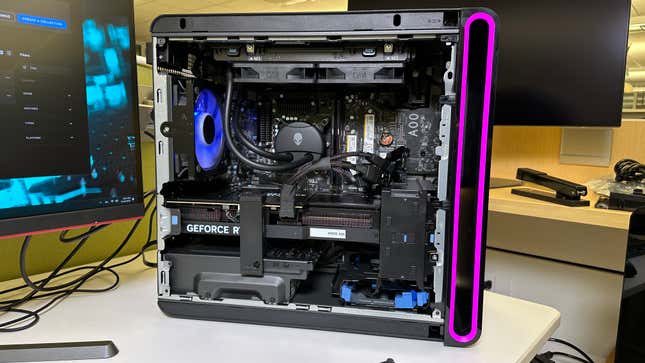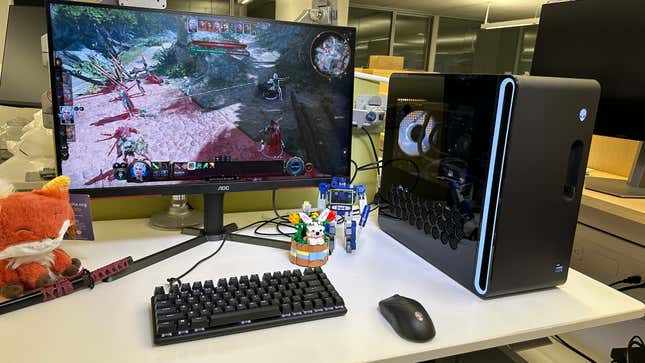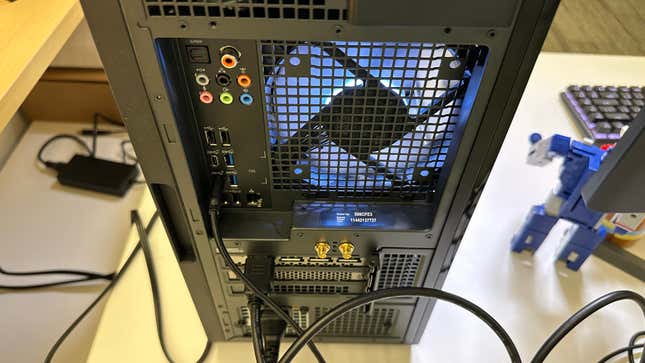Alienware R16
It’s a solid desktop PC with a nice-looking case, though you’re limited on future upgrades.
The Alienware R16 desktop design is a step in the right direction to have a fun, though functional gaming PC. The performance is just what you would want, but the proprietary motherboard means you’ll pay more in the future to upgrade your specs.
Starting at $1,150 (Reviewed at $3,200)
Pros
Very nice-looking case
Cooling system
Performance is what you expect for the high-end specs
Cons
It’s a pain to upgrade thanks to the proprietary motherboard and lack of RAM slots
Since Alienware first unveiled its Aurora R16 last year, I’ve been jonesing to see it in person. The brand had been synonymous with high-end, though strange—often polarizing designs for a while now. Previous Auroras under the so-called “Legend 2” Design had a raised effect, with an odd conical front panel that seemed to come off a starship’s steering apparatus that wasn’t actually designed for human hands. It was certainly unique, but it was also cumbersome and overly large for a mid-range tower.
Advertisement
But the Aurora R16 with the “Legend 3” design ethos seems subdued in comparison, perhaps even elegant in its seeming minimalism and simplicity. The mid-size tower still screams “gamer PC,” but now you can stack things on top of it (though, of course, I’m not suggesting you block the top air vents). Alienware says this new design is 40% smaller than the past Aurora R15. Yet, it still has the same amount of internal breathing room to fit the water cooling system and, at least as far as my version, the Nvidia GeForce RTX 4080 Super graphics card, which itself is big enough to occupy the entire inside of the PC from stem to stern.
Advertisement
But that redesign also begs the question: what’s the point of pre-built PCs if you end up with something that looks like anybody could have built? Sure, you’ll save on the agonies of applying your thermal paste, but that time you spend slotting in your graphics card could turn into savings.
Advertisement
Some would look at the new Alienware tower, with its matte black front panel and single glowing LED strip, and think it “boring.” Me, not as much. The HP-owned gaming hardware brand has been on a kick lately, emphasizing usability, such as reducing the trunk space of the thermal shelf on its latest M16 gaming laptops, first revealed earlier this year. The company has told Gizmodo this isn’t some wholesale attempt at rethinking its aesthetic ethos, but I prefer these new designs to the old ones. The new Aurora PC is scaled to such a degree it will fit neatly on a desk where the soft glow of the LED in both the front air intake and rear fan hit most prominently. I don’t need to be bathed in a veritable rainbow to get in the gaming mood.
Alienware Aurora R16 Case Design and Cooling
The New Case Design is a Better Form Factor, Overall

Advertisement
Alienware’s PCs start at a good price scale but quickly increase as you stack those specs. It’s a baseline PC with a GeForce RTX 4060 and Intel Core i7-13700F, though we’ll touch on upgradeability later. Gizmodo received the 2024 revision of the Aurora R16, which came with 32 GB of DDR5 RAM, an Intel Core i9 14900KF, and a Nvidia GeForce RTX 4080 Super with 16GB of VRAM. That totals out to $3,200 MSRP. It’s all housed on the custom Alienware-branded proprietary motherboard that supports the Intel Z690 chipset. Mind you, that graphics card takes up the entire length and width of the case.
There’s about 35.9 L of space inside the Aurora R16, which is the same as the R15 despite the overall reduction in size. In addition to the proprietary motherboard was the proprietary PSU, in my case, the 1000W Platinum-rated power supply. It also sported the 240 mm liquid cooling setup attached to the CPU housing. While I can’t say whether all the pipes are necessary to cut down on excess heat, it certainly did work toward reducing the overall heat coming out of each vent, even under load.
Advertisement
That front-facing LED strip doubles as the PC’s air intake, making the entire front panel one big wind tunnel. When the internal fans get going, there’s a subtle whistling sound that I was surprised not to find so unpleasant. With the GPU taking up most of the room inside, air flows out the back or top while some air blown by the graphics card fan makes its way out of the side hexagonal vents.
Even under heavy load, the PC never became overly warm. The side air vents don’t register much heat, even under stress. I registered the rear fan at about 100 degrees Fahrenheit max. The top vent is where most of the PC’s heat goes, which makes sense since the CPU cooling system is directly attached to those fans. At max, I read the temperature to be around 111 degrees Fahrenheit after about 30 minutes of play in constant action with Cyberpunk 2077. That’s well within acceptable ranges, though it does mean you shouldn’t be putting anything you care about on top of your Aurora R16, both for the sake of the PC and your precious nicknacks.
Advertisement
Older Alienware PC models were tool-less designs, but the new version requires you to undo one Phillips head and pull on a tab to release the side panel. That’s not a big issue, but it does mean you’ll need a screwdriver nearby if you want to reach inside your PC. There’s essentially no room for additional components, thanks partly to the mounting bracket supporting the massive GPU. Suffice it to say, it’s a nice-looking machine that’s well-built. Just because Alienware looks more standard doesn’t mean the company has compromised on quality.
Alienware Aurora R16 Quality of Life and Upgradability
Proprietary Parts Means There’s Limited Avenues for Upgrading

Advertisement
All the cables are routed behind the motherboard so you can fully view all the internal components. That said, there’s no heat shielding around the RAM, SSD, or Wi-Fi chip. I checked to see if these components were getting extra hot inside, and while I didn’t see anything abnormal, it’s something you should note since it’s a bit odd compared to other pre-built gaming rigs out there. I don’t mind it since there didn’t seem to be any heat issues overall, and I prefer to see my components through the case instead of staring at a bunch of boxes that look like presents I know I will never open.
It’s an overall quiet operation, even under stress, that wasn’t distracting hanging out directly next to me, especially since there was very little air blowing in my direction. It’s not overly bright, and you can use the Alienware Command Center app to change the individual colors and pattern of the LEDs with a few RGB presets. To avoid being too distracted when working on a PC, I would opt for a single block of color. The app also lets you change the AlienFX lighting per title.
Advertisement
So yes, that capability is neatly contained in a package, pretty enough to put a bow on it. What remains its biggest issue is the proprietary nature of the motherboard. There are only two RAM slots, meaning that future memory upgrades require replacing both sticks. Alienware says this actually increases speeds on the system, but even if that’s true, I would take a minutely slower system to make my PC more future-proof. You can also upgrade the GPU and storage, but you won’t be doing much else.
I understand why Alienware would want to build boards for better cable management, but why not give the PC gamer a taste of the joys of eventually upgrading their machine? Just because it’s a beast now doesn’t mean it will stay that way two or even three years down the road.
Advertisement
Alienware Aurora R16 Performance
A Real Gaming Oasis

Advertisement
We tested several games on a QHD monitor at 240 Hz and another 4K monitor at max 160 Hz fresh rates. Really, with stats like these, you already know what framerates to expect from the most demanding titles.
On a game like Cyberpunk 2077, the Aurora could hit an average of 60 FPS on a 240 Hz monitor with ultra settings, full Ray Tracing capabilities enabled, and no DLSS AI super scaling. With DLSS enabled, you can double those frames to an average of 120, though it might dip to around 80 FPS when there’s a gaggle of NPCs on-screen. Once you boost that up to 4K, frames start to dip, so you’re better off enabling DLSS to get it up to an average of 80 FPS with the in-game benchmark.
In Baldur’s Gate III, you can break 140 FPS in indoor locations and feel safe that you won’t dip below 100, except when there are many more NPCs running around in the city areas of Act III. Other games performed very well, easily topping 250 FPS on Halo Infinite and The Finals. Still, gaming at 4K will tank that performance on the highest settings, meaning you should look toward different super scaling options to beat above 60 FPS.
Advertisement
In 3DMark, the Aurora R16 performed just as well as expected in both Time Spy and the higher-end Speed Way tools—that is very, very good. It beat expectations on the QHD monitor and could hold its own at 4K.
This setup works best gaming at sub-4K resolutions, so folks with FHD up through QHD monitors will have a grand old time watching those frames stack up into the triple digits. The 4080 Super can still handle 4K on most titles, though you’ll need a pick-me-up from Nvidia’s superscalar to maintain playable frames on some of the most demanding titles.
Advertisement
With a Core i9-14900KF, the CPU benchmarks were rather strong. I just finished reviewing the Razer Blade 16 with its mobile version of the i9 with the 14900HX, and the Aurora could squeak out a win on Geekbench. The system also crushes our Blender test for rendering a single image of a BMW in just over a minute when relying on the CPU. The i9-14900KF also blasted through a video encoding test using the program Handbrake.
It’s a high-end PC, and it feels that way whether you’re playing games or doing practically anything else.
Advertisement
If You Want to Go Pre-Built, Make Sure It Will Last

Advertisement
Alienware is still an expensive brand; there’s no two ways about it. I can’t guarantee the PC is worth its starting $1,150 price. Still, it’s hard to justify lower specs knowing that there are relatively few upgrade paths if you want to eventually jump from the lower end of 16 GB of RAM to 32 GB—something that will become far more standard in the intervening years.
But if you’re jumping for the ultra-expensive version of the Aurora R16, you won’t come away disappointed by its performance, at the very least. So all that’s left is looks. Aesthetics are all about taste, and to me, previous Alienware desktops seemed to imply that your PC is more than just a gaming rig, something transportation. But I’m not going anywhere. I’d rather know where I am, and the new Aurora R16 is comfortable and pleasing to the eye for somebody like me. I want to feel special without explaining to anybody entering my room that the giant desktop PC isn’t a probing device that fell off a passing saucer.
Services Marketplace – Listings, Bookings & Reviews